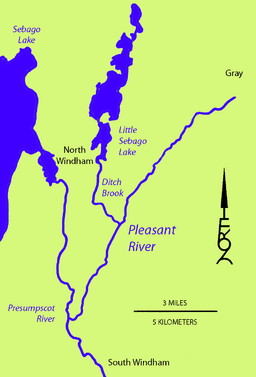Pleasant River (Presumpscot River)
| Pleasant River | |
| river | |
 Pleasant River confluence with Ditch Brook at U.S. Route 302 bridge | |
| Country | United States |
|---|---|
| State | Maine |
| Region | Cumberland County |
| Source | Gray, Maine |
| - coordinates | 43°52′51″N 70°18′34″W / 43.88083°N 70.30944°W [1] |
| Mouth | Presumpscot River |
| - elevation | 121 ft (37 m) |
| - coordinates | 43°45′31″N 70°26′48″W / 43.75861°N 70.44667°WCoordinates: 43°45′31″N 70°26′48″W / 43.75861°N 70.44667°W [1] |
| Length | 13 mi (21 km) |
 | |
The Pleasant River is a 13.1-mile-long (21.1 km)[2] tributary of the Presumpscot River in the U.S. state of Maine.
The Pleasant River originates in the town of Gray and parallels U.S. Route 202 as it flows southwesterly through the town of Windham to discharge into the Presumpscot River upstream of the village of South Windham.
Water power
Early water power surveys found suitable locations at Jackson's Falls or Huston's Falls (where grist, shook, and lumber mills were constructed) near the Gray-Windham town line, a 10-foot (3.0 m) drop at Varney's Falls where a sawmill was constructed near the Route 202 bridge, an 8-foot (2.4 m) drop at Anderson's Falls where a sawmill was constructed near the road from Windham Center to Windham Hill, a 10-foot (3.0 m) drop at Pope's Falls (where lumber, corn, flour, grist, wool carding, and cloth weaving mills were constructed) near Popeville, a 7-foot (2.1 m) drop at Allen's Falls where a sawmill was constructed, and a 10-foot (3.0 m) drop at Baker's Falls where a stave mill was constructed. Colonel Edward Anderson increased flow through these falls by diverting additional water to the Pleasant River through the moraine at the south end of Little Sebago Lake. Water power was developed at the moraine and on the resulting Ditch Brook where a stave mill was built on the Varney Mill Road above the confluence with Pleasant River at the U.S. Route 302 bridge.[3]
Flooding
The outlet control structure at the south end of Little Sebago Lake failed on 4 June 1814, and within a few hours water draining to the Pleasant River eroded a channel through the moraine, dropping the lake elevation 50 feet (15 m). The resulting flood swept away two mills and six bridges along the Pleasant and Presumpscot rivers as far downstream as South Windham.[4] Drainage from Little Sebago Lake was permanently diverted from Outlet Brook into the Pleasant River by destruction of the moraine, although the lake level was partially restored by construction of a stone dam at the narrows in 1860. That dam failed with similar downstream damage on 7 May 1861, but has subsequently been rebuilt.[5]
See also
References
- ↑ 1.0 1.1 U.S. Geological Survey Geographic Names Information System: Pleasant River
- ↑ U.S. Geological Survey. National Hydrography Dataset high-resolution flowline data. The National Map, accessed June 30, 2011
- ↑ Wells, Walter The water-power of Maine (1869) Sprague, Owen & Nash, Augusta
- ↑ Varney, George J. A Gazetteer of the State of Maine (1886) B.B.Russell, Boston
- ↑ Smith, Thomas Lauren History - Town of Windham (1873) Hoyt & Fogg, Portland pp.77-79